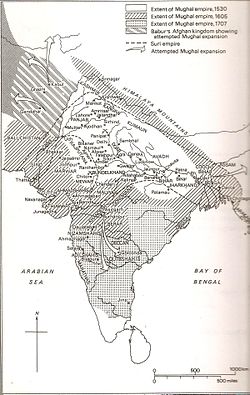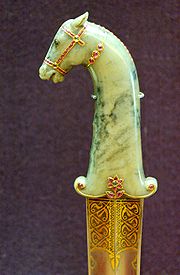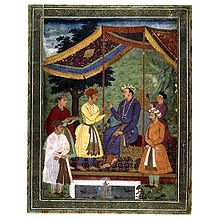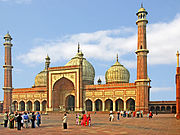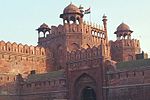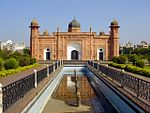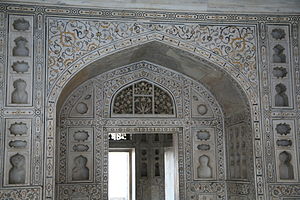- Mughal Empire
-
"Mughals" redirects here. For other uses, see Mughal (disambiguation).
The Mughal Empire
شاهان مغول
Shāhān-e Moġul↓ 1526–1857 ↓ Flag
Mughal Frontiers 1526–1707 Capital Agra; Fatehpur Sikri; Delhi Language(s) Persian (initially also Chagatai Turkic; later also Urdu) Government Absolute monarchy, unitary state
with federal structureEmperor - 1526–1530 Babur - 1530–1539, 1555–1556 Humayun - 1556–1605 Akbar - 1605–1627 Jahangir - 1628–1658 Shah Jahan - 1658–1707 Aurangzeb Historical era Early modern - First Battle of Panipat 21 April 1526 - Indian Rebellion of 1857 20 June 1857 Area - 1700 3,200,000 km2 (1,235,527 sq mi) Population - 1700 est. 150,000,000 Density 46.9 /km2 (121.4 /sq mi) Currency Rupee Preceded by Succeeded by 
Timurid dynasty 
Delhi Sultanate 
Suri dynasty 
Adil Shahi dynasty 
Deccan Sultanates Maratha Empire 
Durrani Empire 
Sikh Empire 
Company Raj 
British Raj 
Hyderabad State 
Today part of  Afghanistan
Afghanistan
 Bangladesh
Bangladesh
 India
India
 Pakistan
PakistanPopulation source:[1] History of South Asia and India - Mehrgarh Culture (7000–3300 BCE)
- Indus Valley Civilization (3300–1700 BCE)
- Early Harappan Culture (3300–2600 BCE)
- Mature Harappan Culture (2600–1900 BCE)
- Late Harappan Culture (1700–1300 BCE)
- Ochre Coloured Pottery culture (from 2000 BCE)
- Swat culture (1600–500 BCE)
- Vedic Civilization (2000–500 BCE)
- Black and Red ware culture (1300–1000 BCE)
- Painted Grey Ware culture (1200–600 BCE)
- Northern Black Polished Ware (700–200 BCE)
- Maha Janapadas (700–300 BCE)
- Magadha Empire (684–424 BCE)
- Nanda Empire (424–321 BCE)
- Chera Empire (300 BCE–1200 CE)
- Chola Empire (300 BCE–1279 CE)
- Pandyan Empire (300 BCE–1345 CE)
- Maurya Empire (321–184 BCE)
- Pallava Empire (250 BCE–800 CE)
- Sunga Empire (185–73 BCE)
- Kanva Empire (75–26 BCE)
- Maha-Megha-Vahana Empire (250s BCE–400s CE)
- Satavahana Empire (230–220 BCE)
- Kuninda Kingdom (200s BCE–300s CE)
- Indo-Scythian Kingdom (200 BCE–400 CE)
- Indo-Greek Kingdom (180 BCE–10 CE)
- Indo-Parthian Kingdom (21–130s CE)
- Western Satrap Empire (35–405 CE)
- Kushan Empire (60–240 CE)
- Indo-Sassanid Kingdom (230–360 CE)
- Vakataka Empire (250s–500s CE)
- Kalabhras Empire (250–600 CE)
- Gupta Empire (280–550 CE)
- Kadamba Empire (345–525 CE)
- Western Ganga Kingdom (350–1000 CE)
- Kamarupa Kingdom (350–1100 CE)
- Vishnukundina Empire (420–624 CE)
- Maitraka Empire (475–767 CE)
- Huna Kingdom (475–576 CE)
- Rai Kingdom (489–632 CE)
- Chalukya Empire (543–753 CE)
- Shahi Empire (500s–1026 CE)
- Maukhari Empire (550s–700s CE)
- Harsha Empire (590–647 CE)
- Eastern Chalukya Kingdom (624–1075 CE)
- Gurjara Pratihara Empire (650–1036 CE)
- Pala Empire (750–1174 CE)
- Rashtrakuta Empire (753–982 CE)
- Paramara Kingdom (800–1327 CE)
- Yadava Empire (850–1334 CE)
- Solanki Kingdom (942–1244 CE)
- Western Chalukya Empire (973–1189 CE)
- Hoysala Empire (1040–1346 CE)
- Sena Empire (1070–1230 CE)
- Eastern Ganga Empire (1078–1434 CE)
- Kakatiya Kingdom (1083–1323 CE)
- Kalachuri Empire (1130–1184 CE)
- Delhi Sultanate (1206–1526 CE)
- Ahom Kingdom (1228–1826 CE)
- Reddy Kingdom (1325–1448 CE)
- Vijayanagara Empire (1336–1646 CE)
- Gajapati Kingdom (1434–1541 CE)
- Deccan Sultanates (1490–1596 CE)
- Mughal Empire (1526–1858 CE)
- Maratha Empire (1674–1818 CE)
- Durrani Empire (1747–1823 CE)
- Sikh Empire (1799–1849 CE)
Regional states (1102–1947 CE)- Zamorin Kingdom (1102–1766 CE)
- Deva Kingdom (1200s–1300s CE)
- Chitradurga Kingdom (1300–1779 CE)
- Garhwal Kingdom (1358–1803 CE)
- Mysore Kingdom (1399–1947 CE)
- Keladi Kingdom (1499–1763 CE)
- Koch Kingdom (1515–1947 CE)
- Thondaiman Kingdom (1650–1948 CE)
- Madurai Kingdom (1559–1736 CE)
- Thanjavur Kingdom (1572–1918 CE)
- Marava Kingdom (1600–1750 CE)
- Sikh Confederacy (1707–1799 CE)
- Travancore Kingdom (1729–1947 CE)
- Portuguese India (1510–1961 CE)
- Dutch India (1605–1825 CE)
- Danish India (1620–1869 CE)
- French India (1759–1954 CE)
- Company Raj (1757–1858 CE)
- British Raj (1858–1947 CE)
- Partition of India (1947 CE)
- Kingdom of Tambapanni (543–505 BCE)
- Kingdom of Upatissa Nuwara (505–377 BCE)
- Kingdom of Anuradhapura (377 BCE–1017 CE)
- Kingdom of Ruhuna (200 CE)
- Polonnaruwa Kingdom (300–1310 CE)
- Kingdom of Dambadeniya (1220–1272 CE)
- Kingdom of Yapahuwa (1272–1293 CE)
- Kingdom of Kurunegala (1293–1341 CE)
- Kingdom of Gampola (1341–1347 CE)
- Kingdom of Raigama (1347–1415 CE)
- Kingdom of Kotte (1412–1597 CE)
- Kingdom of Sitawaka (1521–1594 CE)
- Kingdom of Kandy (1469–1815 CE)
- Portuguese Ceylon (1505–1658 CE)
- Dutch Ceylon (1656–1796 CE)
- British Ceylon (1815–1948 CE)
Nation histories- Afghanistan
- Bangladesh
- Bhutan
- India
- Maldives
- Nepal
- Pakistan
Regional histories- Assam
- Bihar
- Balochistan
- Bengal
- Himachal Pradesh
- Maharashtra
- Uttar Pradesh
- Pakistani Regions
- Punjab
- NWFP
- Orissa
- Sindh
- South India
- Tibet
The Mughal Empire (Persian: شاهان مغول, Shāhān-e Moġul; Urdu: مغلیہ سلطنت; self-designation: گوركانى, Gūrkānī),[2][3] or Mogul (also Moghul) Empire in traditional English usage, was an imperial power from the Indian Subcontinent.[4] The Mughal emperors were descendants of the Timurids. The Mughal Empire began in 1526; at the height of their power in the late 17th and early 18th centuries, they controlled most of the Indian Subcontinent—extending from Bengal in the east to Balochistan in the west, Kashmir in the north to the Kaveri basin in the south.[5] Its population at that time has been estimated as between 110 and 150 million, over a territory of more than 3.2 million square kilometres (1.2 million square miles).[1]
The "classic period" of the empire started in 1556 with the accession of Jalaluddin Mohammad Akbar, better known as Akbar the Great. Under the rule of Akbar the Great, India enjoyed much cultural and economic progress as well as religious harmony. The Mughals also forged a strategic alliance with several Hindu Rajput kingdoms. Some Rajput kingdoms continued to pose a significant threat to Mughal dominance of northwestern India, but they were subdued by the third Mughal Emperor Akbar[6][7]. The reign of Shah Jahan, the fifth emperor, was the golden age of Mughal architecture. He erected many splendid monuments, the most famous of which is the legendary Taj Mahal at Agra, as well as Pearl Mosque, the Red Fort, Jama Masjid (Mosque) and Lahore Fort. The Mughal Empire reached the zenith of its territorial expansion during the reign of Aurangzeb, who may have been the richest and most powerful man alive. During his lifetime, victories in the south expanded the Mughal Empire to more than 1.25 million square miles, ruling over more than 150 million subjects, nearly 1/4th of the world's population.[8][1]
By the early 1700s, the Sikh Misl and the Hindu Maratha Empire had emerged as formidable foes of the Mughals. Following the death of Aurangzeb in 1707, the empire started its gradual decline,[9] although the dynasty continued for another 150 years. During the classic period, the empire was marked by a highly centralized administration connecting the different regions.
Following 1725, the empire began to disintegrate, weakened by wars of succession, agrarian crises fueling local revolts, the growth of religious intolerance, the rise of the Maratha, Durrani, invasion by Safavids from Persia, rise of independent kinngdoms of Oudh, Hyderabad, Mysore, Bengal and Sikh empires and finally British colonialism. The last Emperor, Bahadur Shah II, whose rule was restricted to the city of Delhi, was imprisoned and exiled by the British after the Indian Rebellion of 1857.
The name Mughal is derived from the original homelands of the Timurids, the Central Asian steppes once conquered by Genghis Khan and hence known as Moghulistan, "Land of Mongols". Although early Mughals spoke the Chagatai language and maintained some Turko-Mongol practices, they became essentially Persianized[10] and transferred the Persian literary and high culture[10] to India, thus forming the base for the Indo-Persian culture and the Spread of Islam in South Asia.[11][10]
Contents
Early history
Zahir ud-din Muhammad Babur learned about the riches of Hindustan and conquest of it by his ancestor, Timur, in 1503 at Dikh-Kat, a place in the Transoxiana region. At that time, he was roaming as a wanderer after losing his principality, Farghana. In his memoirs he wrote that after he had acquired Kabul (in 1504), he desired to regain the territories in Hindustan held once by Turks. He started his exploratory raids from September 1519 when he visited the Indo-Afghan borders to suppress the rising by Yusufzai tribes. He undertook similar raids up to 1524 and had established his base camp at Peshawar. Finally in 1526 in his fifth attempt, Babur defeated the last of the Delhi Sultans, Ibrahim Shah Lodi, at the First Battle of Panipat. To secure his newly founded kingdom, Babur then had to face the formidable Rajput Rana Sanga of Chittor, at the Battle of Khanwa. Rana Sanga offered stiff resistance but was defeated.
Babur's son Humayun succeeded him in 1530, but suffered reversals at the hands of the Pashtun Sher Shah Suri and lost most of the fledgling empire before it could grow beyond a minor regional state. From 1540 Humayun became ruler in exile, reaching the court of the Safavid rule in 1554 while his force still controlled some fortresses and small regions. But when the Pashtuns fell into disarray with the death of Sher Shah Suri, Humayun returned with a mixed army, raised more troops, and managed to reconquer Delhi in 1555.
Humayun crossed the rough terrain of the Makran with his wife until their son Akbar was born in the fortress of Umarkot in Sind. The resurgent Humayun then conquered the central plateau around Delhi, but months later died in an accident, leaving the realm unsettled and in war.
Akbar succeeded his father on 14 February 1556, while in the midst of a war against Sikandar Shah Suri for the throne of Delhi. He soon won his eighteenth victory at age 21 or 22. He became known as Akbar, as he was a wise ruler, setting high but fair taxes. He was a more inclusive in his approach to the non-Muslim subjects of the Empire. He investigated the production in a certain area and taxed inhabitants one-fifth of their agricultural produce. He also set up an efficient bureaucracy and was tolerant of religious differences which softened the resistance by the locals. He made alliances with Rajputs and appointed native generals and administrators. Later in life, he devised his own brand of syncretic philosophy based on tolerance.
Jahangir, son of Emperor Akbar, ruled the empire from 1605–1627. In October 1627, Shah Jahan, son of Emperor Jahangir succeeded to the throne, where he inherited a vast and rich empire. At mid-century this was perhaps the greatest empire in the world. Shah Jahan commissioned the famous Taj Mahal (1630–1653) in Agra which was built by the Persian architect Ustad Ahmad Lahauri as a tomb for Shah Jahan's wife Mumtaz Mahal, who died giving birth to their 14th child. By 1700 the empire reached its peak under the leadership of Aurangzeb Alamgir with major parts of present day India, Pakistan, Bangladesh and most of Afghanistan under its domain. Aurangzeb was the last of what are now referred to as the Great Mughal kings, living a shrewd life but dying peacefully.
Mughal dynasty
The Mughal Empire was the dominant power in the Indian subcontinent between the mid-16th century and the early 18th century. Founded in 1526, it officially survived until 1858, when it was supplanted by the British Raj. The dynasty is sometimes referred to as the Timurid dynasty as Babur was descended from Timur.
The Mughal dynasty was founded when Babur, hailing from Ferghana (Modern Uzbekistan), invaded parts of northern India and defeated Ibrahim Shah Lodhi, the ruler of Delhi, at the First Battle of Panipat in 1526. The Mughal Empire superseded the Delhi Sultanate as rulers of northern India. In time, the state thus founded by Babur far exceeded the bounds of the Delhi Sultanate, eventually encompassing a major portion of India and earning the appellation of Empire. A brief interregnum (1540–1555) during the reign of Babur's son, Humayun, saw the rise of the Afghan Suri Dynasty under Sher Shah Suri, a competent and efficient ruler in his own right. However, Sher Shah's untimely death and the military incompetence of his successors enabled Humayun to regain his throne in 1555. However, Humayun died a few months later, and was succeeded by his son, the 13-year-old Akbar the Great.
 A panorama in 12 folds showing the procession of the last Mughal Emperor Bahadur Shah II to celebrate the feast of the Eid ul-Fitr in 1843.
A panorama in 12 folds showing the procession of the last Mughal Emperor Bahadur Shah II to celebrate the feast of the Eid ul-Fitr in 1843.
The greatest portions of Mughal expansion was accomplished during the reign of Akbar (1556–1605). The empire was maintained as the dominant force of the present-day Indian subcontinent for a hundred years further by his successors Jahangir, Shah Jahan, and Aurangzeb. The first six emperors, who enjoyed power both de jure and de facto, are usually referred to by just one name, a title adopted upon his accession by each emperor. The relevant title is bolded in the list below.
Akbar the Great initiated certain important policies, such as religious liberalism (abolition of the jizya tax), inclusion of natives in the affairs of the empire, and political alliance/marriage with the Rajputs, that were innovative for his milieu; he also adopted some policies of Sher Shah Suri, such as the division of the empire into sarkar raj, in his administration of the empire. These policies, which undoubtedly served to maintain the power and stability of the empire, were preserved by his two immediate successors but were discarded by Emperor Aurangzeb who spent nearly his entire career expanding his realm, beyond the Urdu Belt, into the Deccan and South India, Assam in the east; this venture provoked resistance from the Marathas, Sikhs, and Ahoms.
Decline
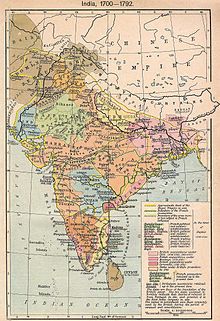 Sikh and Maratha states gained territory after the Mughal empire's decline. Map showing territories in 1700 and 1792
Sikh and Maratha states gained territory after the Mughal empire's decline. Map showing territories in 1700 and 1792
After Emperor Aurangzeb's death in 1707, the empire fell into succession crisis. Barring Muhammad Shah, none of the Mughal emperors could hold on to power for a decade. In the 18th century, the Empire suffered the depredations of invaders like Nadir Shah of Persia and Ahmed Shah Abdali of Afghanistan, who repeatedly sacked Delhi, the Mughal capital. Most of the empire's territories in India passed to the Marathas, Nawabs, and Nizams by c. 1750. In 1804, the blind and powerless Shah Alam II formally accepted the protection of the British East India Company. The company had already begun to refer to the weakened emperor as "King of Delhi", rather than "Emperor of India". The once glorious and mighty Mughal army was disbanded in 1805 by the British; only the guards of the Red Fort were spared to serve with the King Of Delhi, which avoided the uncomfortable implication that British sovereignty was outranked by the Indian monarch. Nonetheless, for a few decades afterward the BEIC continued to rule the areas under its control as the nominal servants of the emperor and in his name. In 1857, even these courtesies were disposed. After some rebels in the Sepoy Rebellion declared their allegiance to Shah Alam's descendant, Bahadur Shah II, the British Raj decided to abolish the institution altogether. They deposed the last Mughal emperor in 1857 and exiled him to Burma, where he died in 1862.
List of Mughal emperors
History of the Mongols 
Before Genghis Khan Khamag Mongol Mongol Empire Khanates - Chagatai Khanate - Golden Horde - Ilkhanate - Yuan Dynasty Northern Yuan Timurid Empire Mughal Empire Crimean Khanate Khanate of Sibir Zunghar Khanate Mongolia during Qing Outer Mongolia (1911-1919) Republic of China (Occupation of Mongolia) Mongolian People's Republic (Outer Mongolia) Modern Mongolia Mengjiang (Inner Mongolia) People's Republic of China (Inner Mongolia) Republic of Buryatia Kalmyk Republic Hazara Mongols Aimak Mongols Timeline edit box Certain important particulars regarding the Mughal emperors is tabulated below:
Emperor Birth Reign Period Death Notes Zaheeruddin Muhammad Babur Feb 23, 1483 1526–1530 Dec 26, 1530 Founder of the Mughal Dynasty. Nasiruddin Muhammad Humayun Mar 6, 1508 1530–1540 Jan 1556 Reign interrupted by Suri Dynasty. Youth and inexperience at ascension led to his being regarded as a less effective ruler than usurper, Sher Shah Suri. Sher Shah Suri 1472 1540–1545 May 1545 Deposed Humayun and led the Suri Dynasty. Islam Shah Suri c.1500 1545–1554 1554 2nd and last ruler of the Suri Dynasty, claims of sons Sikandar and Adil Shah were eliminated by Humayun's restoration. Nasiruddin Muhammad Humayun Mar 6, 1508 1555–1556 Jan 1556 Restored rule was more unified and effective than initial reign of 1530–1540; left unified empire for his son, Akbar. Jalaluddin Muhammad Akbar Nov 14, 1542 1556–1605 Oct 27, 1605 Akbar greatly expanded the Empire and is regarded as the most illustrious ruler of the Mughal Dynasty as he set up the empire's various institutions; he married Mariam-uz-Zamani, a Rajput princess. One of his most famous construction marvels was the Lahore Fort. Nooruddin Muhammad Jahangir Oct 1569 1605–1627 1627 Jahangir set the precedent for sons rebelling against their emperor fathers. Opened first relations with the British East India Company. Reportedly was an alcoholic, and his wife Empress Noor Jahan became the real power behind the throne and competently ruled in his place. Shahaabuddin Muhammad Shah Jahan Jan 5, 1592 1627–1658 1666 Under him, Mughal art and architecture reached their zenith; constructed the Taj Mahal, Jama Masjid, Red Fort, Jahangir mausoleum, and Shalimar Gardens in Lahore. Deposed and imprisoned by his son Aurangzeb. Mohiuddin Muhammad Aurangzeb Alamgir Oct 21, 1618 1658–1707 Mar 3, 1707 He reinterpreted Islamic law and presented the Fatawa-e-Alamgiri; he captured the diamond mines of the Sultanate of Golconda; he spent more than 20 years of his life defeating major rebel factions in India; his conquests expanded the empire to its greatest extent; the over-stretched empire was controlled by Nawabs, and faced challenges after his death. He made two copies of the Qur'an using his own calligraphy. Bahadur Shah I Oct 14, 1643 1707–1712 Feb 1712 First of the Mughal emperors to preside over a steady and severe decline in the territories under the empire's control and military power due to the rising strength of the autonomous Nawabs. After his reign, the empire went into steady decline. Jahandar Shah 1664 1712–1713 Feb 1713 He was highly influenced by his Grand Vizier Zulfikar Khan. Furrukhsiyar 1683 1713–1719 1719 In 1717 he granted a firman to the English East India Company granting them duty free trading rights for Bengal and confirmed their position in India. Rafi Ul-Darjat Unknown 1719 1719 Rafi Ud-Daulat
a.k.a Shah Jahan IIUnknown 1719 1719 Nikusiyar Unknown 1719 1743 Muhammad Ibrahim Unknown 1720 1744 Muhammad Shah 1702 1719–1720, 1720–1748 1748 Got rid of the Syed Brothers. Fought a long war with the Maratha Empire, losing Deccan and Malwa in the process. Suffered the invasion of Nadir-Shah of Persia in 1739. He was the last Mughal Emperor to preside effective control over the empire. Ahmad Shah Bahadur 1725 1748–54 1754 Mughal forces massacred by the Maratha during the Battle of Sikandarabad; Alamgir II 1699 1754–1759 1759 Consolidation of power of the Nizam of Hyderabad,Nawab of Oudh, Marathas, State of Mysore & Nawab of Bengal,Bihar,Orissa; Shah Jahan III Unknown In 1759 1770s Shah Alam II 1728 1759–1806 1806 Defeat of the combined forces of Mughal, Nawab of Oudh & Nawab of Bengal,Bihar at the hand of East India Company at the Battle of Buxar. Treaty of Allahabad. Hyder Ali becomes Nawab of Mysore in 1761. Ahmed-Shah-Abdali in 1761 defeated the Marathas during the Third Battle of Panipat; The fall of Tipu Sultan of Mysore in 1799; Akbar Shah II 1760 1806–1837 1837 Titular figurehead under British protection Bahadur Shah Zafar 1775 1837–1857 1862 The last Mughal emperor was deposed by the British and exiled to Burma following the Indian Rebellion of 1857. Influence on the Indian subcontinent
Mughal architecture
Mughal influence on Indian art & culture
A major Mughal contribution to the Indian subcontinent was their unique architecture. Many monuments were built by the Muslim emperors, especially Shahjahan, during the Mughal era including the UNESCO World Heritage Site Taj Mahal, which is known to be one of the finer examples of Mughal architecture. Other World Heritage Sites includes the Humayun's Tomb, Fatehpur Sikri, Red Fort, Agra Fort, and Lahore Fort.
The palaces, tombs, and forts built by the dynasty stands today in Agra, Aurangabad, Delhi, Dhaka, Fatehpur Sikri, Jaipur, Lahore, Kabul, Sheikhupura, and many other cities of India, Pakistan, Afghanistan, and Bangladesh.[12] With few memories of Central Asia, Babur's descendents absorbed traits and customs of the Indian Subcontinent,[13] and became more or less naturalised.
Mughal influence can be seen in cultural contributions such as[14]:
- Centralised, imperialistic government which brought together many smaller kingdoms.[15]
- Persian art and culture amalgamated with Indian art and culture.[16]
- New trade routes to Arab and Turkic lands.
- The development of Mughlai cuisine.[17]
- Mughal Architecture found its way into local Indian architecture, most conspicuously in the palaces built by Rajputs and Sikh rulers.
- Landscape gardening
Although the land the Mughals once ruled has separated into what is now India, Pakistan, Bangladesh, and Afghanistan, their influence can still be seen widely today. Tombs of the emperors are spread throughout India, Afghanistan,[18] and Pakistan. There are 16 million descendants spread throughout the Subcontinent and possibly the world.[19][unreliable source?]
Urdu language
Although Persian was the dominant and "official" language of the empire, the language of the elite later evolved into a form of Hindustani today known as Urdu. Highly Persianized and also influenced by Arabic and Turkic, the language was written in a type of Perso-Arabic script known as Nastaliq, and with literary conventions and specialized vocabulary being retained from Persian, Arabic and Turkic; the new dialect was eventually given its own name of Urdu. Compared with Hindi, the Urdu language draws more vocabulary from Persian and Arabic (via Persian) and (to a much lesser degree) from Turkic languages where Hindi draws vocabulary from Sanskrit more heavily.[20] Modern Hindi, which uses Sanskrit-based vocabulary along with Urdu loan words from Persian and Arabic, is mutually intelligible with Urdu.[21]
Mughal society
The Indian economy remained as prosperous under the Mughals as it was, because of the creation of a road system and a uniform currency, together with the unification of the country. Manufactured goods and peasant-grown cash crops were sold throughout the world. Key industries included shipbuilding (the Indian shipbuilding industry was as advanced as the European, and Indians sold ships to European firms), textiles, and steel. The Mughals maintained a small fleet, which merely carried pilgrims to Mecca, imported a few Arab horses in Surat. Debal in Sindh was mostly autonomous. The Mughals also maintained various river fleets of Dhows, which transported soldiers over rivers and fought rebels. Among its admirals were Yahya Saleh, Munnawar Khan, and Muhammad Saleh Kamboh. The Mughals also protected the Siddis of Janjira. Its sailors were renowned and often voyaged to China and the East African Swahili Coast, together with some Mughal subjects carrying out private-sector trade. Cities and towns boomed under the Mughals; however, for the most part, they were military and political centres, not manufacturing or commerce centres. Only those guilds which produced goods for the bureaucracy made goods in the towns; most industry was based in rural areas. The Mughals also built Maktabs in every province under their authority, where youth were taught the Quran and Islamic law such as the Fatawa-e-Alamgiri in their indigenous languages.
The nobility was a heterogeneous body; while it primarily consisted of Rajput aristocrats and foreigners from Muslim countries, people of all castes and nationalities could gain a title from the emperor. The middle class of openly affluent traders consisted of a few wealthy merchants living in the coastal towns; the bulk of the merchants pretended to be poor to avoid taxation. The bulk of the people were poor. The standard of living of the poor was as low as, or somewhat higher than, the standard of living of the Indian poor under the British Raj; whatever benefits the British brought with canals and modern industry were neutralized by rising population growth, high taxes, and the collapse of traditional industry in the nineteenth century.
Science and technology
Astronomy
The 16th and 17th centuries saw a synthesis between Islamic astronomy, where Islamic observational techniques and instruments were employed techniques. While there appears to have been little concern for theoretical astronomy, Mughal astronomers continued to make advances in observational astronomy and produced nearly a hundred Zij treatises. Humayun built a personal observatory near Delhi, while Jahangir and Shah Jahan were also intending to build observatories but were unable to do so. The instruments and observational techniques used at the Mughal observatories were mainly derived from the Islamic tradition.[22][23] In particular, one of the most remarkable astronomical instruments invented in Mughal India is the seamless celestial globe (see Technology below).
Technology
Fathullah Shirazi (c. 1582), a Persian-Indian polymath and mechanical engineer who worked for Akbar the Great in the Mughal Empire, developed a volley gun.[24]
Considered one of the most remarkable feats in metallurgy, the seamless globe was invented in Kashmir by Ali Kashmiri ibn Luqman in 998 AH (1589–90 CE), and twenty other such globes were later produced in Lahore and Kashmir during the Mughal Empire. Before they were rediscovered in the 1980s, it was believed by modern metallurgists to be technically impossible to produce metal globes without any seams, even with modern technology. Another famous series of seamless celestial globes was produced using a lost-wax casting method in the Mughal Empire in 1070 AH (1659–1960 CE) by Muhammad Salih Tahtawi with Arabic and Persian inscriptions. It is considered a major feat in metallurgy. These Mughal metallurgists pioneered the method of wax casting while producing these seamless globes.[25]
See also
- Mughal (tribe)
- Mughal architecture, a style of architecture
- Mughal gardens, a style of gardens
- Mughal cuisine, a style of cooking
- Mughal painting, a style of painting
- Mughal weapons
- Mughal-e-Azam, an India film
- Mirza Mughal, fifth son of Bahadur Shah II, the last Mughal emperor
- History of India
- Muslim conquest in the Indian subcontinent
- Mongols, one of several ethnic groups
- Turco-Persian/Turco-Mongol
- List of the Muslim Empires
- List of Sunni Muslim dynasties
- Islamic architecture
- Timurid dynasty
- Charlemagne to the Mughals
Notes
- ^ a b c Richards, John F. (March 26, 1993). Johnson, Gordon; Bayly, C. A.. eds. The Mughal Empire. The New Cambridge history of India: 1.5. I. The Mughals and their Contemporaries. Cambridge: Cambridge University Press. pp. 1, 190. doi:10.2277/0521251192. ISBN 978-0521251198.
- ^ Zahir ud-Din Mohammad (September 10, 2002). Thackston, Wheeler M.. ed. The Baburnama: Memoirs of Babur, Prince and Emperor. New York: Modern Library. p. xlvi. ISBN 978-0375761379. "In India the dynasty always called itself Gurkani, after Temür's title Gurkân, the Persianized form of the Mongolian kürägän, 'son-in-law,' a title he assumed after his marriage to a Genghisid princess."
- ^ Balfour, E.G. (1976). Encyclopaedia Asiatica: Comprising Indian-subcontinent, Eastern and Southern Asia. New Delhi: Cosmo Publications. S. 460, S. 488, S. 897. ISBN 978-8170203254.
- ^ "The Mughal Empire"
- ^ menloschool.org[dead link]
- ^ http://www.columbia.edu/itc/mealac/pritchett/00islamlinks/ikram/part2_11.html
- ^ http://www.columbia.edu/itc/mealac/pritchett/00islamlinks/ikram/graphics/india1605.jpg
- ^ http://www.youtube.com/watch?v=P-Ygz9VbiE0
- ^ "Mughal Empire (1500s, 1600s)". bbc.co.uk. London: British Broadcasting Corporation. Section 5: Aurangzeb. http://www.bbc.co.uk/religion/religions/islam/history/mughalempire_1.shtml. Retrieved 18 October 2010.
- ^ a b c Robert L. Canfield, Turko-Persia in historical perspective, Cambridge University Press, 1991. pg 20: "The Mughals – Persianized Turks who invaded from Central Asia and claimed descent from both Timur and Genghis – strengthened the Persianate culture of Muslim India"
- ^ http://www.columbia.edu/itc/mealac/pritchett/00islamlinks/ikram/part2_10.html
- ^ Ross Marlay, Clark D. Neher. 'Patriots and Tyrants: Ten Asian Leaders' pp.269 ISBN 0847684423
- ^ webindia123.com-Indian History-Medieval-Mughal Period-AKBAR
- ^ Mughal Contribution to Indian Literature | Writinghood
- ^ "Mughal Empire – MSN Encarta". Archived from the original on 2009-11-01. http://www.webcitation.org/5kx6SG3s9.
- ^ Indo-Persian Literature Conference: SOAS: North Indian Literary Culture (1450–1650)
- ^ Mughlai Recipes, Mughlai Dishes – Cuisine, Mughlai Food
- ^ The garden of Bagh-e Babur : Tomb of the Mughal emperor
- ^ Descendants of Mughal came together to rehabilitate the Mughal Dynasty | TwoCircles.net
- ^ "A Brief Hindi – Urdu FAQ". sikmirza. Archived from the original on 2007-12-02. http://web.archive.org/web/20071202103338/http://www.geocities.com/sikmirza/arabic/hindustani.html. Retrieved 2008-05-20.
- ^ Urdu Dictionary Project is Under Threat : ALL THINGS PAKISTAN
- ^ Sharma, Virendra Nath (1995), Sawai Jai Singh and His Astronomy, Motilal Banarsidass Publ., pp. 8–9, ISBN 8120812565
- ^ Baber, Zaheer (1996), The Science of Empire: Scientific Knowledge, Civilization, and Colonial Rule in India, State University of New York Press, pp. 82–9, ISBN 0791429199
- ^ Bag, A. K. (2005). "Fathullah Shirazi: Cannon, Multi-barrel Gun and Yarghu". Indian Journal of History of Science (New Delhi: Indian National Science Academy) 40 (3): 431–436. ISSN 0019-5235.
- ^ Savage-Smith, Emilie (1985), Islamicate Celestial Globes: Their history, Construction, and Use, Smithsonian Institution Press, Washington, D.C.
Further reading
- Manucci, Niccolao; tr. from French by François Catrou (1826). History of the Mogul dynasty in India, 1399–1657. London : J.M. Richardson. http://www.archive.org/stream/historyofmoguldy00manurich#page/n5/mode/2up.
- The Tezkereh al vakiat or Private Memoirs of the Moghul Emperor Humayun Written in the Persian language by Jouher A confidential domestic of His Majesty. John Murray, London. 1832. http://www.archive.org/stream/tezkerehalvakiat00jawhuoft#page/n7/mode/2up.
- Elliot, Sir H. M., Edited by Dowson, John. The History of India, as Told by Its Own Historians. The Muhammadan Period; published by London Trubner Company 1867–1877. (Online Copy at Packard Humanities Institute – Other Persian Texts in Translation; historical books: Author List and Title List)
- Invasions of India from Central Asia. London, R. Bentley and Son. 1879. http://www.archive.org/stream/invasionsofindia00londrich#page/n5/mode/2up.
- Hunter, William Wilson, Sir (1893). "10. The Mughal Dynasty, 1526–1761". A Brief history of the Indian peoples. Oxford: Clarendon Press. http://www.archive.org/stream/briefhistoryindi00hunt#page/n7/mode/2up.
- Adams, W. H. Davenport (1893). Warriors of the Crescent. London: Hutchinson. http://www.archive.org/stream/warriorsofcresce00adamuoft#page/n9/mode/2up.
- Holden, Edward Singleton (1895). The Mogul emperors of Hindustan, A.D. 1398- A.D. 1707. New York : C. Scribner's Sons. http://www.archive.org/stream/mogulemperorsofh00hold#page/n9/mode/2up.
- Malleson, G. B (1896). Akbar and the rise of the Mughal empire. Oxford : Clarendon Press. http://www.archive.org/stream/akbarriseofmugha00mallrich#page/n5/mode/2up.
- Lane-Poole, Stanley (1906). History of India: From Mohammedan Conquest to the Reign of Akbar the Great (Vol. 3). London, Grolier society. http://www.archive.org/stream/historyofindia03jackuoft#page/n9/mode/2up.
- Lane-Poole, Stanley (1906). History of India: From Reign of Akbar the Great to the Fall of Moghul Empire (Vol. 4). London, Grolier society. http://www.archive.org/stream/historyofindia04jackuoft#page/n9/mode/2up.
- Manucci, Niccolao; tr. by William Irvine (1907). Storia do Mogor; or, Mogul India 1653–1708, Vol. 1. London, J. Murray. http://www.archive.org/stream/storiadomogororm01manuuoft#page/n7/mode/2up.
- Manucci, Niccolao; tr. by William Irvine (1907). Storia do Mogor; or, Mogul India 1653–1708, Vol. 2. London, J. Murray. http://www.archive.org/stream/storiadomogororm02manuuoft#page/n7/mode/2up.
- Manucci, Niccolao; tr. by William Irvine (1907). Storia do Mogor; or, Mogul India 1653–1708, Vol. 3. London, J. Murray. http://www.archive.org/stream/storiadomogororm03manuuoft#page/n9/mode/2up.
- Owen, Sidney J (1912). The Fall of the Mogul Empire. London, J. Murray. http://www.archive.org/stream/fallofmogulempir00owenuoft#page/n5/mode/2up.
- Burgess, James (1913). The Chronology of Modern India for Four Hundred Years from the Close of the Fifteenth Century, A.D. 1494–1894.. John Grant, Edinburgh. http://www.archive.org/stream/chronologyofmode00burg#page/n5/mode/2up.
- Irvine, William (1922). Later Mughals, Vol. 1, 1707–1720. London, Luzac & Co.. http://www.archive.org/stream/latermughals01irviuoft#page/n3/mode/2up.
- Irvine, William (1922). Later Mughals, Vol. 2, 1719–1739. London, Luzac & Co.. http://www.archive.org/stream/latermughals02irviuoft#page/n3/mode/2up.
- Bernier, Francois (1891). Travels in the Mogul Empire, A.D. 1656–1668. Archibald Constable, London. http://www.archive.org/stream/travelsinmogulem00bernuoft#page/ii/mode/2up.
- Preston, Diana and Michael; Taj Mahal: Passion and Genius at the Heart of the Moghul Empire; Walker & Company; ISBN 0802716733.
- The Moghul Economy and Society; Chapter 2 of Class Structure and Economic Growth: India & Pakistan since the Moghuls; By Maddison (1971)
External links
- Mughals and Swat
- Mughal India an interactive experience from the British Museum
- The Mughal Empire from BBC
- Mughal Empire
- The Great Mughals
- Gardens of the Mughal Empire
- Indo-Iranian Socio-Cultural Relations at Past, Present and Future, by M.Reza Pourjafar, Ali
- A. Taghvaee, in Web Journal on Cultural Patrimony (Fabio Maniscalco ed.), vol. 1, January–June 2006
- Adrian Fletcher's Paradoxplace — PHOTOS — Great Mughal Emperors of India
- A Mughal diamond on BBC
- Some Mughal coins with brief history
A history of empires Ancient empires Medieval empires Byzantine · Hunnic · Arab (Rashidun · Umayyad · Abbasid · Fatimid · Caliphate of Córdoba · Ayyubid) · Moroccan (Idrisid · Almoravid · Almohad · Marinid) · Persian (Tahirid · Samanid · Buyid · Sallarid · Ziyarid) · Ghaznavid · Bulgarian (First · Second) · Benin · Great Seljuq · Oyo · Bornu · Khwarezmian · Aragonese · Timurid · Indian (Chola · Gurjara-Pratihara · Pala · Eastern Ganga dynasty · Delhi) · Mongol (Yuan · Golden Horde · Chagatai Khanate · Ilkhanate) · Kanem · Serbian · Songhai · Khmer · Carolingian · Holy Roman · Angevin · Mali · Chinese (Sui · Tang · Song · Yuan) · Wagadou · Aztec · Inca · Srivijaya · Majapahit · Ethiopian (Zagwe · Solomonic) · Somali (Ajuuraan · Warsangali) · AdaliteModern empires Tongan · Indian (Maratha · Sikh · Mughal) · Chinese (Ming · Qing) · Ottoman · Persian (Safavid · Afsharid · Zand · Qajar · Pahlavi) · Moroccan (Saadi · Alaouite) · Ethiopian · Somali (Dervish · Gobroon · Hobyo) · French (First · Second) · Austrian (Austro-Hungarian) · German · Russian · Swedish · Mexican (First · Second) · Brazil · Korea · Japan · Haitian (First · Second) · Central AfricanColonial empires  Iran topics
Iran topicsHistory Pre-IslamicPrehistory · Proto-Elamite civilization BCE 3200– BCE 2800 · Elamite dynasties BCE 2800– BCE 550 · Bactria-Margiana Complex BCE 2200– BCE 1700 · Kingdom of Mannai BCE 10th– BCE 7th cent. · Median Empire BCE 728– BCE 550 · Achaemenid Empire BCE 550– BCE 330 · Seleucid Empire BCE 330– BCE 150 · Greco-Bactrian Kingdom BCE 250– BCE 125 · Parthian Empire BCE 248–CE 224 · Kushan Empire CE 30–CE 275 · Sassanid Empire CE 224–CE 651 · Hephthalite Empire CE 425–CE 557 · Kabul Shahi kingdom CE 565–CE 879
IslamicPatriarchal Caliphate 637–651 · Umayyad Caliphate 661–750 · Abbasid Caliphate 750–1258 · Tahirid dynasty 821–873 · Alavid dynasty 864–928 · Saffarid dynasty 861–1003 · Samanid dynasty 819–999 · Ziyarid dynasty 928–1043 · Buyid dynasty 934–1055 · Ghaznavid Empire 975–1187 · Ghori dynasty 1149–1212 · Seljuk Empire 1037–1194 · Khwarezmid dynasty 1077–1231 · Ilkhanate 1256–1335 · Kartids dynasty 1231–1389 · Ottoman Empire 1299–1923 · Muzaffarid dynasty 1314–1393 · Chupanid dynasty 1337–1357 · Jalayerid dynasty 1339–1432 · Timurid Empire 1370–1506 · Qara Qoyunlu Turcomans 1407–1468 · Aq Qoyunlu Turcomans 1378–1508 · Safavid Empire 1501–1722 or 1736 · Hotaki dynasty 1722–1729 · Afsharid dynasty 1736–1750 · Zand Dynasty 1750–1794 · Durrani Empire 1794–1826 · Qajar Dynasty 1794–1925
ModernSee also: Greater Iran · Ancient Iran · Iranian Cultural Continent · Indo-Iranians (languages) · Jiroft civilization · Aryans · Persian peoples · Iranian peoples · Tajiks · Kings of Persia · Military history · Years in IranPolitics
GovernmentIntellectual movements · Women's movement · Elections · Constitution · Supreme Leader · President · Judicial system · Assembly of Experts · Parliament · Guardian Council · Expediency Discernment Council · Supreme National Security Council · City and Village Councils · Human rights (LGBT) · Officials · Provincial governors · Reformists · Principlists · United Nations Security Council Resolution 1747 · Ambassadors · Foreign relations · Ministry of Intelligence · Terrorism · Military (Army · Air Force · Navy) · Censorship · Nuclear program · Allegations of state terrorism · Iranian Green Revolution Anglo-Iranian Oil Company · Operation Ajax · White Revolution · Iranian Revolution · Embassy siege · Iran-Iraq war · Iran Air Flight 655 · 1987 massacre of Iranian pilgrims · Chicago's Persian heritage crisis · History of the Islamic Republic of Iran · Iranian Presidential Election, 2009 · Persian Constitutional Revolution ·Demographics Iranian citizens (abroad) · Religion · Muslims · Bahá'ís · Christians · Armenians · Jews · Ethnic minorities · Religious minorities · Zoroastrians (persecution) · WomenLanguages Geography Cities (list) · Iranian Azerbaijan · Iranian Balochistan · Iranian Kurdistan · Iranian Plateau · Islands · Mountains · Provinces · Earthquakes · WildlifeEconomy Economic history of Iran · Agriculture · Fruit · Industry · Water and sanitation · Health care · Central bank · Companies (automobile manufacturers - Banks) · Research centers · Brain drain · Iran Electronics Industries (IEI) · Military equipment · IDRO · National Iranian Oil Company (NIOC) · Iran Aviation Industries Organization (IAIO) · Space · Milad Tower and complex · Military exports · Rial · Tehran Stock Exchange · Electronic banking · Intellectual property · International Oil Bourse · Bonyad · Asalouyeh industrial corridor · Kish Island Free Trade Zone · Chabahar Free Trade-Industrial Zone · Labor and tax laws · Economic Cooperation Organization (ECO) · Mining · Construction · Privatization · Foreign Direct Investment · Supreme Audit Court · Communications · Telecommunication Company of Iran (TCI) · Transport · Railways · Metro · Airlines · Iran Shipping Lines · Energy · Petroleum industry · Nuclear program · Tourism · Environmental issues · Economic Reform Plan · Middle East economy · List of major economic laws in Iran · Iran and WTO · Economic history of IranSociety
CultureIranian nationality · Iranology · Education (Higher · Science · Scientists and scholars · Universities) · Philosophy · List of Iranians · Literature · Media (News agencies (student) · newspapers) · Architecture (architects) · Achaemenid architecture · Art (modern/contemporary) · Persian gardens · Cinema · Cuisine · Public holidays · National symbols · Opium consumption · Music (Ey Iran · Heavy metal · Persian traditional music · Folk · Pop · Rap and hip-hop · Rock and alternative) · Blogs · Mythology · Folklore · Islam · Islamization · Scouting · Sport (Football)Other topics Calendar · Crown jewels · Anti-Iranianism · Persian names · Tehrangeles · International rankings of Iran · Sorood-e Shahanshahi IranCategories:- Former countries in South Asia
- Former empires
- States and territories established in 1526
- States and territories disestablished in 1857
- History of Iran
- Mughal Empire
- 1857 disestablishments
- Muslim dynasties
- Post-medieval history of Pakistan
- History of medieval India
Wikimedia Foundation. 2010.


